Ankara - Ethnographical Museum
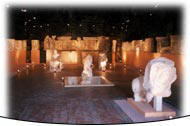 This museum is built on a hill known as Muslim Cemetery at the Namazgah District of Ankara. The site was allotted to the Ministry of Education by the General Directorate of Foundations on 15 November 1925 for the purpose of building a museum.
This museum is built on a hill known as Muslim Cemetery at the Namazgah District of Ankara. The site was allotted to the Ministry of Education by the General Directorate of Foundations on 15 November 1925 for the purpose of building a museum.
For the revolutionaries, the participants of the Independence War, preserving the material and spiritual heritage of the Turkish culture, and the necessity to build an ethnographical museum was an important issue. For that matter, the Minister of Education Hamdullah Suphi Tanriöver asked one of the directors of the Budapest Ethnographical Museum and his old time turcologist colleague J. Meszaros for his expertise on establishing such a museum and offered him the job. The fact we know from a report submitted to the Ministry on 29 November 1924 by Prof. Meszaros. Therefore, first in 1924 under the leadership of Prof. Celal Esad (Arseven) in Istanbul and later in 1925 under Halil Ethem (Erdem), the director of Istanbul Museum, a special committee was formed for the preparations of establishing a Folks Museum and for the collection and purchasing of the necessary art works. Later in 1927, after the completion of the building, these 1250 purchased items put on display in this museum. First director of the museum was Hamit Zübeyr Kosar.
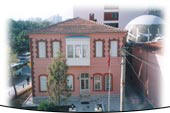 Gazi Mustafa Kemal, after visiting and having been informed about the museum on 15 April 1928, ordered the opening of the museum on the occasion of Afghan King Amanullah Han’s official visit to Türkiye. The museum opened to public on 18 July 1930 and remained open until the inner court was converted to a temporary grave for Atatürk. Atatürk's coffin stayed in this court until it was transferred to Anitkabir in 1953. This section of the museum is still preserved as a symbolic mausoleum in memory of Atatürk with an inscription on a white marble plate, saying:
Gazi Mustafa Kemal, after visiting and having been informed about the museum on 15 April 1928, ordered the opening of the museum on the occasion of Afghan King Amanullah Han’s official visit to Türkiye. The museum opened to public on 18 July 1930 and remained open until the inner court was converted to a temporary grave for Atatürk. Atatürk's coffin stayed in this court until it was transferred to Anitkabir in 1953. This section of the museum is still preserved as a symbolic mausoleum in memory of Atatürk with an inscription on a white marble plate, saying:
“This is the place where Atatürk rested in peace between 21 November 1938 and 10 November 1953 after his death on 10 November 1938.”
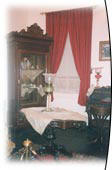 For 15 years the Ethnographical Museum functioned as a mausoleum where all heads of states, ambassadors, foreign envoys and people visited Atatürk with respect. During this time improvement works continued in the museum and completed, on the occasion of the International Week of Museums 6-14 November 1956, opened again to public exhibition.
For 15 years the Ethnographical Museum functioned as a mausoleum where all heads of states, ambassadors, foreign envoys and people visited Atatürk with respect. During this time improvement works continued in the museum and completed, on the occasion of the International Week of Museums 6-14 November 1956, opened again to public exhibition.
The architect of the building Arif Hikmet (Koyunoglu) is one of the most valued architects of the Republican period.
The building has a rectangular plan and one central dome. Its masonry walls are plated with küfeki stone mand marble coronets have carved decorations.
Grand stairs to the building have 28 risers. Triple entry has four columns outside and inside is the domed hall. You can also enter the colonnaded inner court from this hall. The inner court had a marble pool with an open roof. Later, when it was converted as a temporary grave for Atatürk, the pool was relocated into the garden and the inner court was enclosed with a roof. In a symmetrical way the inner court is surrounded with various sizes of display halls. Two-storey administration section is adjacent to the museum.
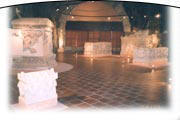 The bronze statue of Atatürk mounted on a horse in front of the museum, made by the Italian artist P. Conanica, had been ordered by the National Education Ministry in 1927.
The bronze statue of Atatürk mounted on a horse in front of the museum, made by the Italian artist P. Conanica, had been ordered by the National Education Ministry in 1927.
Turkish Art works from Seljuk period to present are on display in the Ethnographical Museum.
Displayed folk attires, ornaments, clogs and shoe examples, local Sivas women’s and men’s socks, purses, embroideries, embroidered kerchiefs, belts, napkins, bundles, quilts, brides wedding dresses, bridegrooms shaving sets are all good samples of traditional Turkish (Folk) art works collected from every corner of Anatolia.
 There is a rich collection of kilims and rugs woven in local workshops from Bergama, Kula, Milas, Ladik, Karaman, Nigde and Kirsehir, all with peculiar technics, materials and styles.
There is a rich collection of kilims and rugs woven in local workshops from Bergama, Kula, Milas, Ladik, Karaman, Nigde and Kirsehir, all with peculiar technics, materials and styles.
Many good samples of Anatolian ironmongery art work, such as 15th Century Memluk cauldrons, Ottoman sherbet cauldrons, brass and copper bowls, ewers, jugs and coffee trays, jugs, cups, dishes and candle holders are also on display.
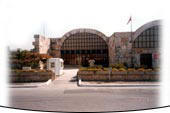 Ottoman period bows, arrows, flint pistols and rifles, swords, yataghans, Turkish china and Kütahya porcelains, articles related to Sufis and other dervish orders and good examples of Turkish calligraphy art are all displayed in the museum.
Ottoman period bows, arrows, flint pistols and rifles, swords, yataghans, Turkish china and Kütahya porcelains, articles related to Sufis and other dervish orders and good examples of Turkish calligraphy art are all displayed in the museum.
Seljuk Sultan III. Keyhüsrev’s throne (12th Century), Ahi Serafettin’s Sarcophagus (14th Century), the altar of Tashur Pasha Mosque from Damsa village, Ürgüp, Nevsehir (12th Century), the pulpit of Siirt Ulu Mosque (12th Century), and the crown door of Merzifon Celebi Sultan Medresseh (15th Century) are the most beautiful examples of Turkish woodwork and important items displayed in the museum.
The collection, donated to the museum by VII. term member of the Turkish National Grand Assembly Besim Atalay contains Turkish art works belonging to various periods.
The museum’s specialized library compiles works, related to Anatolian ethnography, folk art and history of fine arts.
Address: Talatpasa Bulvari, Opera / Ankara
Telephone: +90 (312) 311 95 56